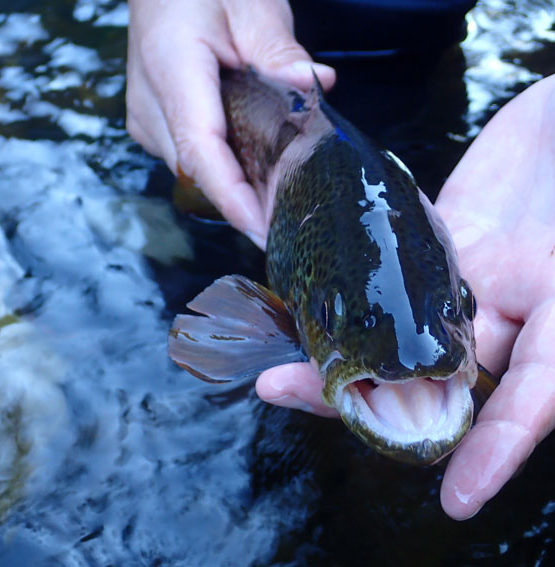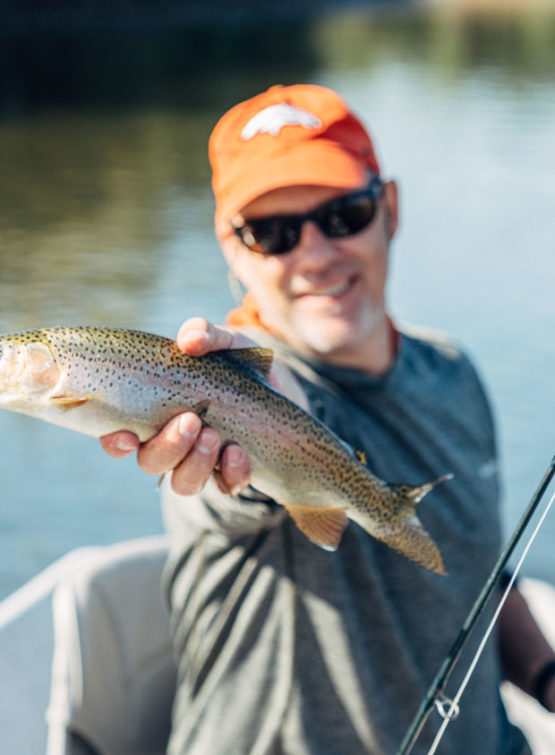With over 20 years of fly fishing experience under my wading belt, I have either seen, or committed just about every fly fishing mistake under the sun. And that got me thinking, what if I had been aware of all these mistakes from the get go?
How many more fish would I have caught along the way had I known to avoid them?
Probably a lot. And that’s exactly why I decided to write this post.
If you are new to fly fishing, there’s no need for you to make the same mistakes. You should just learn from mine.
So, in today’s post, I am going to cover 21 common fly fishing mistakes you should avoid. I hope this post will put you on the fast-track to fly fishing success.
Let’s get started!
Disclaimer: This post may contain affiliate links, meaning we will receive a small commission (at no cost to you) if you click through and make a purchase.1. False Casting Too Much
The false cast is probably the coolest — most picturesque — thing about fly fishing. So, once a newbie angler learns how to do it, it’s hard to get them to stop. The problem with this, is that the longer you keep your flies off the water, the fewer fish you are going to catch.
With very few exceptions, you should only ever false cast a maximum of two or three times. Any more than that, and you are just trying to show off. Plus, false casting increases your risk of tangles and wind knots. Do you really want to risk that?
Related Content:
- 10 Reasons You Should Take Up Fly Fishing
- How To Tie A Double Nymph Rig? A Step-By-Step Guide
- How Much Should You Tip A Fishing Guide?
- 25 Best Dry Flies For Colorado Fly Fishing
- How To Read A River: 9 Tips To Catch More Trout
- How To Hold A Trout For Photos
2. Casting Too Quickly
One of the most difficult struggles for a beginner angler is figuring out the proper timing of a good cast. In most cases, they don’t allow enough time for their line to properly load. In other words, the timing between their backcast and their forward cast is too quick.
And, when that happens, you will either end up with a bad tangle, or your line piling up on the water about three feet in front of you. Weak.
If you want to be a good caster, you need to practice patience and allow your backcast enough time to load before you start your forward cast.
3. Casting Without Authority
One of the other common fly fishing mistakes I see anglers make, is casting without authority. I’m not really sure what causes this, but my theory is that many anglers are afraid they are going to hit themself in the face with their rig if they get too aggressive. Truthfully though, that is more likely to happen if you make a weak backcast.
If you want to make good casts, you need to show your rod who’s boss.
So, when you lift your line off the water, and begin your backcast, give it a little extra muscle. If you combine an authoritative cast with good timing, you will be casting like a pro in no time.
Join Fly Fishing Fix, Today!
4. The Two-Handed Cast
One of the easiest ways to spot a beginner in the world of fly fishing, is the two-handed cast.
You see, most beginners know to hold and manage their excess fly line (i.e. the slack line between your first rod guide and your reel) with their non-casting hand, which is good. However, they tend to hold it while also holding their rod, which is bad.
So, when they cast, they end up casting with both hands against the handle. This is not only improper casting technique, but it just doesn’t look right.
As any experienced angler will show you, your non-casting hand should manage your fly line separate from your casting hand; usually around your waist. For example, I am right-handed. So, when I cast, I keep my left hand near my left waist, and manage my line from there. That allows my right arm to operate independent of my left, and gives me a full range of casting motion.
Learning to manage your line like this will prepare you for more advanced casting techniques like the double and triple haul later on.
5. Using The Wrong Size Tippet Or Leader
One of the most important things you should learn when getting into fly fishing is which size and type of tippet and leader you should use for different situations. It’s not a very complicated subject to learn, and it can be the difference between getting skunked, and a day of fishing success.
To give you a general overview, for smaller streams, creeks and ponds, you should opt for lighter-test tippet and leader (i.e. 5X, 6X and even 7X). If you are fishing large rivers or lakes, known for bigger, hard-fighting fish, you should use stronger test tippet (i.e. 2X, 3X and 4X).
Related Posts:
- Do You Need Tippet For Fly Fishing?
- How Long Does Tippet Last? (Plus 5 Tips To Make It Last Longer)
- Is Fly Fishing Hard To Learn? (The Truth)
6. Netting Fish From Behind
I learned this tip after a very unfortunate netting accident. You see, my dad and I were fishing the Taylor River, and he hooked the trout of a lifetime. I’m not joking when I tell you this thing was over 30 inches long. So, in an effort to help him land it, I stepped into the river just downstream of him, and waited for my opportunity to net it.
That’s when I made a very critical mistake. When it came within reach of my net, I tried to slide my net up under its tail, and the fish thrashed back upstream and the hook came out of its mouth. (I’m sick just thinking about it.)
You see, the thing about trout, is they can only swim in the direction they are looking. So when you net a fish, tail-first — especially a big fish — they will just swim out of your net. That’s why you should always net a fish head-first. This method offers two benefits. First of all, the tension of your line restricts their ability to swim in the opposite direction of your net. Secondly, since fish can only swim forward, they will unknowingly swim directly into your net. It’s a beautiful technique, that has never failed me.
I only wish I’d learned it earlier.
Sorry Dad. (Cue the sad music.)
7. Avoiding Rig Changes
When you’re first starting out, rig changes take forever. I mean, tying knots with almost invisible line can be a daunting task. So, I can understand why beginners tend to avoid doing it. But, if you want to become a better angler, you need to be willing to change your rig fairly often.
The sooner you embrace that, the more fish you will catch.
I recommend you get yourself a spool of regular fishing line, and practice tying knots while you watch tv at night. The more you practice and improve your rigging skills, the less you’ll avoid them when you’re on the water. And that will lead to more fish.
8. Not Being Stealthy
Judging by the loud, thrashing behavior of many anglers, you would think fish were the least skittish species on the planet. Unfortunately, that’s just not the case.
Fish do not take kindly to loud, obnoxious behavior. So, if you want to catch more of them, you need to learn to be stealthy.
In particular, you should avoid wearing bright colors, approaching fishing spots from upstream, casting your shadow over the water, and thrashing through the water like a dog in a pool.
The more you blend in with your surroundings, and the quieter you are, the more likely you are to catch fish.
9. Letting A Dry Fly Skate
One of the most critical fly fishing mistakes you need to avoid, is letting your dry fly skate across the surface. Nothing will wreck a good dry fly presentation than your fly getting pulled by the current of the water. Fish are smart enough to know something isn’t right when that happens, and more often than not, they will pass on your fly.
Now, that said, there are times when skating a dry fly makes sense. In fact, sometimes a little skating can be just the ticket. All I’m saying is that unless it is intentional, you should avoid letting your dry fly skate.
10. Not Checking Your Rig
When you are fly fishing, you should constantly check your rig for moss, mud, tangles, knots, or anything else that might keep your rig from looking like the tasty treat it is. Fish don’t eat little mud balls floating down a river, so don’t try and serve that to them.
At minimum, you should check your rig every 10 to 20 casts, and make sure your flies look ok.
11. Missing Subtle Takes
Part of the art of fly fishing, and more specifically, nymphing, is learning to identify subtle takes. I mean, it’s easy to spot a take when your strike indicator moves 6 feet upstream, but that’s not how most fish hit a fly.
As a beginner, if you see your strike indicator, “dodge, duck, dip, dive, or… dodge,” then set that hook. I can’t tell you how many times I have been fishing with a beginner, that didn’t realize a little tiny twitch of their indicator was actually a fish.
To this day, if my indicator shows even the slightest sign of a fish, I don’t second guess it. I just set the hook.
12. Not Setting The Hook Downstream
One of the hardest things for anglers to learn, is a proper hook set. Most of the time, inexperienced anglers will just rip their rod straight up toward the sky, and pull the fly right out of the fish’s mouth.
The proper technique is to set the hook by pulling your rod to the downstream side. For example, if I am casting from the side of a river that is flowing right to left, I will set the hook by pulling my rod to the left side of my body.
This is logical when you think about it. If fish face upstream, and you set the hook by pulling your line downstream, then you are pulling your fly toward their mouth.
It is a hard habit to adopt, but it is the best way to set a hook.
13. Using Too Much Line
One of the fly fishing mistakes that can get you into trouble is using too much line. I have personally made this mistake about a million times, and it always makes my life more difficult.
When you fly fish with too much line out, you are creating a couple problems for yourself:
All your excess line gathers at your feet, which will magically wrap itself around your legs, get tangled in your boots, and end up tying itself in a knot around the hook on your gravel guards. To make things worse, this almost always happens when you are standing in swift current.
If you happen to hook a fish while you have too much line out — which you undoubtedly will — you will end up reeling in a giant gnarled mess that you will have to try to untangle while fighting a fish. Trust me when I tell you that this often leads to disappointment.
14. Overspending On Gear
The fly fishing industry is full of awesome gear and nifty gadgets. But, spending top dollar on a bunch of slick new fly fishing gear will not make you a better fly fisherman. You know what will? learning the fundamentals of fishing, and improving your technique.
Some of the best angers I know fish with a rod and reel setup that’s over a decade old.
Don’t spend more money on new gear. Spend more time fly fishing.
15. Improper Mending Technique
Learning to mend your line properly is what separates the pros from the amateurs in fly fishing.
Mending your line properly allows you to maintain a good fly presentation throughout the entirety of your drift. So, from the second your fly hits the water, to the moment you lift your rod to cast, your fly presentation doesn’t miss a beat.
In my opinion, the best way to learn proper mending technique, is to have an experienced angler, or better yet, a guide show you how.
16. Avoiding Small Flies
In my experience, one of the things that surprises beginners the most about fly fishing is how small the flies are. Additionally, I have found that many of them think that bigger flies must attract bigger fish.
But this is a huge mistake.
In my experience, fish are more attracted to small flies. In fact, most of the biggest fish I have ever landed were caught on a size 18 fly or smaller.
In the words of Nigel Powers, “It’s not the size, mate. It’s how you use it.”
17. Too Much Slack
I saw a bumper sticker on a truck with a Rod Vault on top the other day that said, “Slack is evil”, and I was like, “got that right!”
Too much slack when you’re fly fishing is a sure-fire way to miss takes, and lose fish. So, when you cast your line, and it starts drifting back toward you, strip in that slack as fast as possible. Otherwise, you won’t be able to apply enough tension to your line to set the hook.
Can you say, “bye bye fishie!”
18. Tying Bad Knots
Of all the things you need to learn in order to be a self-sufficient angler, fly fishing knots are the hardest. Between the handshake knot, clinch knot, nail knot, blood knot, surgeon’s knot, and a few others, fly fishing requires a good amount of knowledge in the knot-tying arena.
Unfortunately, most anglers don’t take the time to learn how to tie these knots properly, and it often ends up costing them some fish.
Don’t make the same — lazy — mistake so many anglers make. Learn to tie as many fly fishing knots as possible.
19. Impatience
I think most people know that fly fishing takes a good amount of patience. I know this, because about 50% of the time when I tell a non-fisherman that I’m a fly fisherman, they respond by saying, “I don’t have the patience for that.”
Well, it turns out many fly fishermen don’t either.
Impatience is one of the biggest mistakes I see anglers make.
Sometimes you need to spend an hour casting in a specific hole before you start to see fish take interest. Other times you will need to have the patience to completely re-rig or untangle your line.
The more patient you are, the more enjoyable fly fishing will be for you, and — I can’t stress this enough — the more fish you will catch.
20. Not Adding Enough Weight
If you want to get into nymphing, you need to adopt the following mantra… add more weight.
Over the years, I have fished all sorts of places, in all sorts of conditions, and the one constant is that if I don’t have enough weight on my rig to get it down to the bottom, I don’t catch as many fish.
So, whether you are fishing a small stream or a giant river, don’t be afraid to add more weight. If you find yourself snagging the bottom too much, you can always take a little bit off. But, until you get your flies down to the fish, you just aren’t going to catch much of anything.
21. Improper Strike Indicator Placement
One of the more subtle fly fishing mistakes you can make when you’re nymphing, is placing your indicator too high, or too low on your leader. What makes this mistake particularly difficult, is that most anglers just do this by feel. So, if you ask somebody with more fly fishing experience for a little bit of guidance, they will probably just tell you to try different placements.
Luckily, I have a straight answer for you.
You should place your strike indicator 1.5X the depth of the water, above the first fly in my rig.
In other words, if you’re fishing a stream that is approximately 3 feet deep, you should place your indicator 4.5 feet above your first fly.
I received this tip from a guide when I was about 20 years old, and it continues to serve me extremely well.
Related Post: Do You Need a Strike Indicator? “Naked Nymphing”
Bottom Line
If you want to up your fly fishing game, then there are all sorts of common mistakes you should avoid. From simple mistakes like making too many false casts, or netting fish tail-first, to more technical mistakes like the two-handed cast, or not setting the hook downstream, I hope this list has helped you in some way.
Now, get out there and fish!











great article on 21 fly fishing mistakes